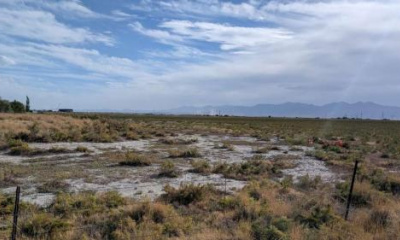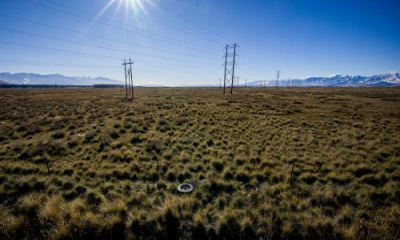Plaintiffs want a mandated elevation for the depleted lake in an effort to protect public health and a fragile ecosystem.
Environmental groups have filed a lawsuit to save the Great Salt Lake as its water continues receding and its lakebed blows dust.
The case uses a legal concept that recently stifled plans to turn Utah Lake into a private island development and, years ago, stopped a salty lake from getting sucked dry in California.
A complaint filed in 3rd District Court on Wednesday invokes the public trust doctrine, claiming the Utah Department of Natural Resources (DNR) has failed in its duty to protect the largest saline ecosystem in the Western Hemisphere for the benefit of its residents. While lawmakers and resource managers have taken steps in recent years to bolster the imperiled Great Salt Lake and the unique ecology it supports, they must take more drastic steps to reduce Utahns’ overconsumption of water, the suit argues.
“These clients are extremely concerned about the future of the lake and impacts to public health,” said Stu Gillespie, lead attorney with Earth Justice representing the groups bringing the case.
Those plaintiffs include Utah Physicians for a Healthy Environment, American Bird Conservancy, Center for Biological Diversity, Sierra Club and Utah Rivers Council.
In an emailed statement, DNR Director Joel Ferry said he couldn’t comment on the specifics of the litigation.
“There has been unprecedented interest, investment and action to preserve and protect the Great Salt Lake in recent years,” Ferry said. “The state has been actively working with many interested parties on the lake. Working together, we have found more productive ways to effect change.”
He invited others to join in the effort to find solutions for the lake, along with the ecosystem and communities tied to its fate.
The Great Salt Lake supports more than 10 million migrating birds, billion-dollar minerals businesses and a multimillion-dollar brine shrimp harvesting industry. And Utahns were nearly set to lose all those assets as the lake withered to its lowest-record elevation for the second year in a row last November.
The southern half of the lake swelled 5.5 feet this spring. But that’s partly due to it getting sealed off from the northern half and partly due to an anomalous winter of abundant snow. Policy change alone has yet to make any measurable difference for the lake, which teetered over the brink of ecological collapse at this time last year.
Meanwhile, the lake continues to generate harmful dust storms, despite unprecedented spring runoff.
“We think this is the most important environmental issue the state of Utah has ever faced,” said Brian Moench with Utah Physicians for a Healthy Environment, “We are disappointed we have to go to this extent, but we feel we don’t have any other choice.”
Utah Physicians successfully sued the Diesel Brothers in federal court in 2020, in a case upheld by the appeals court the following year. The reality TV personalities tampered with trucks so they could “roll coal,” spewing diesel smoke that both violated air quality standards and posed a public health risk.
The Great Salt Lake case will get argued in state court and calls on Utah regulators to take urgent action before dwindling water results in a massive die-off of birds, brine shrimp and other species, and its drying lakebed poisons millions of people living on the Wasatch Front.
“As trustee, the State of Utah has an ongoing obligation,” the complaint argues, “to protect the Great Salt Lake’s waters and underlying lands, so that Utahns can continue to use them for navigation, commerce, brine shrimp fishing, recreation, and other uses recognized under the public trust doctrine.”
DNR’s Division of Forestry, Fire and State Lands manages the lake bed that’s desiccating into toxic dust. And DNR’s Division of Water Rights manages the state’s water that’s getting siphoned away.
“Great Salt Lake is facing enormous peril,” said Deeda Seed, Utah campaigner for the Center for Biological Diversity. “If concerted action isn’t taken immediately we could lose the lake and the human health consequences of that are unimaginably dire.”
About two-thirds of the water that would otherwise flow to the Great Salt Lake gets consumed by humans, which the lawsuit calls “unsustainable.” It calls on the state to curb water diversions until the lake rises to 4,198 feet above sea level, the minimum elevation needed to support industry, recreation, public health and the environment.
The south arm currently sits at 4,192.4 feet and the north arm sits at 4,189.0 feet. The Great Salt Lake’s record low, set last fall, is 4,188.5 feet.
“Every Utahn should be very worried about Utah’s failure to restore the Great Salt Lake,” said Zach Frankel, executive director of Utah Rivers Council. “We have the tools available to us to raise the Great Salt Lake’s water levels. But we’re failing to hold our elected and appointed officials accountable for even establishing so much as a goal to raise the lake.”
A Democratic senator attempted to set a target elevation for the lake during this year’s legislative session, but his proposal did not make it out of committee. Lawmakers instead set a salinity trigger that authorized state resource managers to seal off the rock-filled railroad berm splitting the lake in two, and potentially build more causeways to keep at least a portion of the Great Salt Lake viable.
“A salinity trigger is not going to save the lake,” Frankel said. “You can dike the lake and shrink it down to maintain a salinity level. That’s not going to solve the air quality disaster.”
Michael Parr, president of the national conservation group American Bird Conservancy, said he got involved in the Utah suit because the lake has “global” significance for avian migration.
“It’s a national treasure from a bird point of view,” Parr said. “If Great Salt Lake dries up, those birds will have nowhere else to go.”
The public trust doctrine successfully saved another saline lake on the other side of the Great Basin decades ago. The Mono Lake case made waves among legal scholars and water rights attorneys when the California courts determined it couldn’t legally be siphoned to dust by the city of Los Angeles, which held most of the rights to the lake’s tributaries.
Judges found the state had to strike a balance between the needs of both water right owners and the environmental, public trust needs of the lake. After rigorous review, regulators in that state settled on an elevation — 20 feet higher than Mono Lake’s historic low. Thirty years later, it has yet to reach that mandate. But it did stave off the lake’s rapid rate of decline.
In Utah, regulators studied and documented the elevations needed to sustain a healthy Great Salt Lake in 2013. But policymakers overhauled state water law to help the lake get there only a decade later, after the lake hit a record low.
Plaintiffs in the public trust case say it’s not enough.
“Saving saline lakes is hard, we’re seeing that globally,” Seed said. “Which is another reason why we’re bringing litigation now and asking for an immediate remedy.”
DNR recently demonstrated it is willing to tap the public trust doctrine to preserve a lake for the benefit of state residents. A group of developers aggressively pursued plans to dredge Utah Lake and use a billion cubic yards of its sediment to build island real estate that would one day become home to half a million people.
But last year, the Division of Forestry, Fire and State Lands sunk that plan when they determined it was unconstitutional. As with the Great Salt Lake, the state owns Utah Lake’s lakebed, and must manage it for the good of the public, not turn it over to private, for-profit interests, state officials found.
Preserving an ecological gem like Great Salt Lake, and remedying what’s already become a big source of air pollution, also serves the public interest, the lawsuit claims.
“With this litigation, we see this as an opportunity for solutions,” Gillespie said. “... To show other states how to do this right, and, frankly, show the world there are ways to achieve a viable lake elevation.”








